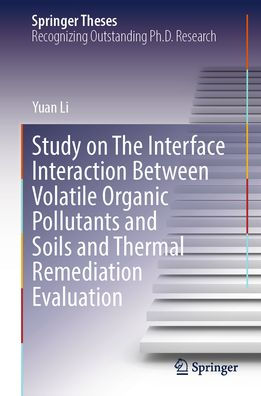Study on The Interface Interaction Between Volatile Organic Pollutants and Soils and Thermal Remediation Evaluation
From a microperspective, this book investigates the interface interaction between organic pollutants and soil skeleton, as well as the electrochemical response and the interface mechanical mechanism of contaminated soil in thermal environments. Considering interface behaviors and mechanisms, a one-dimensional soil column and a large-scale three-dimensional laboratory model using steam injection technology were self-developed for the first time to discuss the removal pathways and effectiveness of pollutants under heat-moisture conditions in a simulated in-situ soil stress. In addition, this book also focuses on the mechanical performance and biological resilience of the thermally remediated soil to expand the reuse scenarios of these wastes. This study effectively integrates interdisciplinary knowledge such as soil mechanics, fluid flow in porous medium, and environmental chemistry and innovatively conducts systematic research using theoretical, experimental, and numerical simulation methods to fill the gap in current research on the interaction behaviors, fate mechanisms, remediation pathways, and reuse potential of organic contaminated soils. The methodology established in this book provides a good foundation for the characterization, efficient remediation, and reutilization of organic contaminated soils, filling the gap of a single discipline in solving the issue of contaminated sites and broadening the research perspective and depth for geo-environmental engineering.
1147319860
Study on The Interface Interaction Between Volatile Organic Pollutants and Soils and Thermal Remediation Evaluation
From a microperspective, this book investigates the interface interaction between organic pollutants and soil skeleton, as well as the electrochemical response and the interface mechanical mechanism of contaminated soil in thermal environments. Considering interface behaviors and mechanisms, a one-dimensional soil column and a large-scale three-dimensional laboratory model using steam injection technology were self-developed for the first time to discuss the removal pathways and effectiveness of pollutants under heat-moisture conditions in a simulated in-situ soil stress. In addition, this book also focuses on the mechanical performance and biological resilience of the thermally remediated soil to expand the reuse scenarios of these wastes. This study effectively integrates interdisciplinary knowledge such as soil mechanics, fluid flow in porous medium, and environmental chemistry and innovatively conducts systematic research using theoretical, experimental, and numerical simulation methods to fill the gap in current research on the interaction behaviors, fate mechanisms, remediation pathways, and reuse potential of organic contaminated soils. The methodology established in this book provides a good foundation for the characterization, efficient remediation, and reutilization of organic contaminated soils, filling the gap of a single discipline in solving the issue of contaminated sites and broadening the research perspective and depth for geo-environmental engineering.
249.99
Pre Order
5
1

Study on The Interface Interaction Between Volatile Organic Pollutants and Soils and Thermal Remediation Evaluation
253
Study on The Interface Interaction Between Volatile Organic Pollutants and Soils and Thermal Remediation Evaluation
253
249.99
Pre Order

Product Details
| ISBN-13: | 9789819673230 |
|---|---|
| Publisher: | Springer Nature Singapore |
| Publication date: | 07/23/2025 |
| Series: | Springer Theses |
| Pages: | 253 |
| Product dimensions: | 6.10(w) x 9.25(h) x (d) |
About the Author
From the B&N Reads Blog
